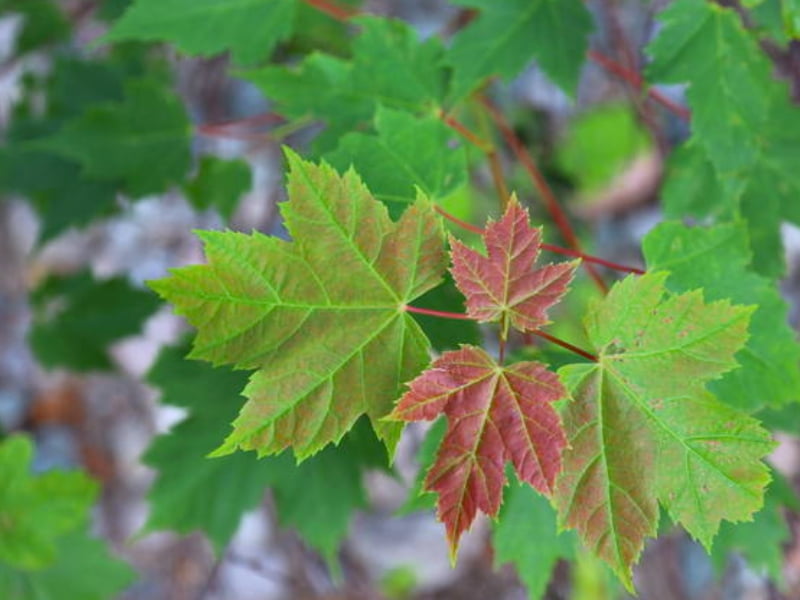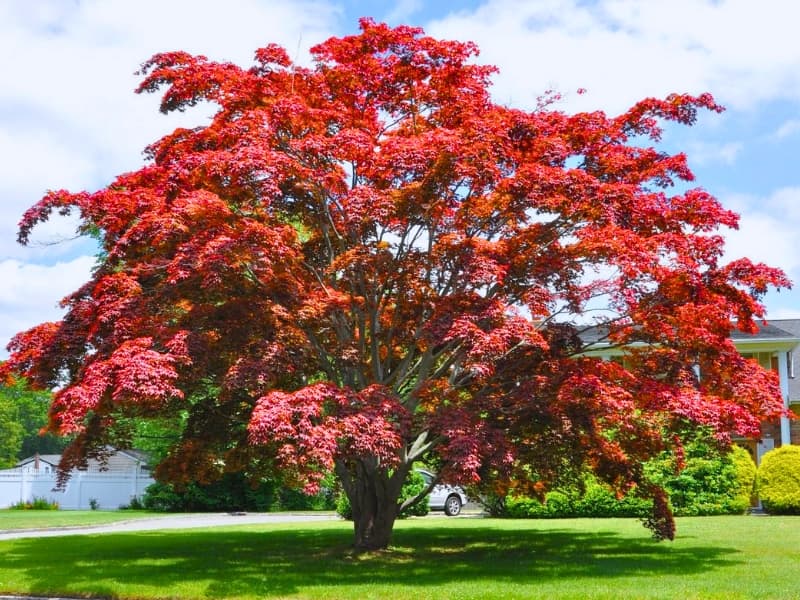American Red Maple Tree, also widely recognized by its common names swamp maple, water maple, or soft maple, and scientifically known as Acer rubrum, is a captivating deciduous tree native to eastern and central North America. Its stunning fall foliage, ranging from brilliant yellow to fiery orange and deep crimson, makes it a highly sought-after landscaping choice, providing unmatched aesthetic appeal. These adaptable trees are relatively fast-growing and tolerate a wide range of soil conditions, making them a practical choice for many gardens.
At Gardencenterpoint.com, we understand the appeal of the Acer rubrum. This guide offers comprehensive solutions for selecting, planting, and caring for your Red Maple, ensuring it thrives and becomes a stunning focal point in your landscape. Whether you are looking to buy a Red Maple tree or need information on Red Maple tree care, we have you covered.

Why American Red Maple is a Landscape Superstar?
The American Red Maple (Acer rubrum) isn’t just a tree; it’s a statement. It’s the embodiment of autumnal beauty, a living canvas that transforms with the seasons. Imagine a crisp autumn morning, the sun glinting off leaves that blaze with an intensity unmatched by any other tree. That’s the magic of the Red Maple. But its appeal extends far beyond its fall color. This tree is a workhorse, offering shade in the summer, habitat for wildlife, and a sense of enduring beauty throughout the year.
| Common name | American Red Maple, Swamp Maple, Water Maple, Soft Maple |
| Botanical name | Acer rubrum |
| Family | Sapindaceae |
| Genus | Acer |
| Species | rubrum |
| Origin | Eastern and Central North America |
| Life cycle | Perennial |
| Plant type | Deciduous Tree |
| Hardiness zone | 3-9 |
| Sunlight | Full Sun to Partial Shade |
| Maintenance | Moderate |
| Water | Moderate to High (Prefers Moist Soil) |
| Drainage | Well-Drained (Tolerant of Wet Sites) |
| Spacing | 30-50 ft. (Depending on Cultivar) |
| Flowering period | Spring (Before Leaves Emerge) |
| Height | 40-120 ft. (Depending on Cultivar) |
| Spread | 30-75 ft |
| Growth rate | Medium to Fast (1-2 ft. per year, potentially more in optimal conditions) |
| Flower color | Red (Small, but noticeable) |
| Leaf color | Green (Summer), Yellow, Orange, Red (Fall) |
| Stem color | Reddish-brown (Young Twigs), Gray (Mature Bark) |
| Flower benefit | Early Spring Nectar Source for Pollinators |
| Garden style | Shade Garden, Woodland Garden, Naturalistic Garden |
| Uses | Shade Tree, Specimen Tree, Street Tree (with adequate space), Fall Color, Wildlife Habitat} |
| Soil pH | Prefers slightly acidic, adaptable |
| Propagation | Seeds, cuttings, grafting (for specific cultivars) |
| Deer resistance | Moderate |
The American Red Maple’s popularity isn’t just anecdotal. According to a 2023 report by the Arbor Day Foundation, Acer rubrum consistently ranks among the top 10 most popular trees planted in urban and suburban areas across the United States. This popularity is driven by several factors:
- Adaptability: The Red Maple can tolerate a surprisingly wide range of conditions. While it prefers moist, slightly acidic soil, it can adapt to everything from swampy areas to relatively dry sites. This makes it a versatile choice for homeowners with varying soil types.
- Fast Growth: Compared to some other shade trees, like oaks, Red Maples grow relatively quickly. This means you’ll see a noticeable difference in your landscape in a shorter amount of time. While growth rates vary depending on conditions, you can expect an average of 1-2 feet of growth per year, and in optimal conditions, even more.
- Stunning Fall Color: This is the primary reason most people choose a Red Maple. The intensity and range of colors – from golden yellow to fiery orange and deep scarlet – are simply breathtaking. The specific color will vary depending on the cultivar, soil conditions, and climate, but the display is almost always spectacular.
- Wildlife Value: Red Maples provide food and shelter for a variety of wildlife. Birds feed on the seeds, squirrels nest in the branches, and insects find sustenance in the leaves and bark.
- Size Variety: There are many cultivars. The size at maturity goes from 40 to 120 feet.
A study by the University of Florida IFAS Extension highlighted the importance of selecting the right cultivar for your specific region and needs. For example, ‘Red Sunset’ is known for its consistently brilliant red fall color, while ‘October Glory’ holds its leaves later into the season. Choosing the right cultivar ensures you get the desired characteristics and performance from your tree. There are hundreds of named cultivars. Here is a listing of some of the more popular red maples, along with notes on their characteristics:
| Cultivar | Height (feet) | Fall Color | Characteristics |
| Autumn Blaze | 50-60 | Orange-red | Fast-growing, good drought tolerance |
| Red Sunset | 45-50 | Brilliant red | Excellent, consistent color, one of the best |
| October Glory | 40-50 | Deep red | Holds leaves late into fall, good for southern climates |
| Northwood | 40-50 | Orange-red | Very cold-hardy, good for northern climates |
| Summer Red | 30-40 | Reddish-bronze in summer | Unique summer foliage color, smaller size |
| Schlesingeri | 70-80 | Deep Red | One of the oldest cultivars and also one of the tallest |

This table provides a starting point for selecting a Red Maple cultivar. It’s essential to research the specific needs and characteristics of each cultivar before making a final decision. We at Gardencenterpoint.com can help guide you through the selection process, providing access to information and resources from reputable nurseries and growers.
Choosing Your Perfect Red Maple
Selecting the right American Red Maple for your landscape is like choosing the perfect piece of art for your home. It requires careful consideration of your space, your preferences, and the tree’s individual characteristics. Let’s embark on a journey to find the ideal Red Maple for your garden.
Assess Your Site
Before you even start browsing catalogs or visiting nurseries, take a good look at your property. Consider the following factors:
- Sunlight: Red Maples prefer full sun (at least six hours of direct sunlight per day) for optimal growth and fall color. However, they can tolerate partial shade, especially in hotter climates.
- Soil: As mentioned earlier, Red Maples are adaptable, but they prefer moist, well-drained, slightly acidic soil. A simple soil test (available at most garden centers) can tell you the pH of your soil and whether any amendments are needed. If your soil is heavily alkaline, you may need to amend it with sulfur or choose a different tree species.
- Space: Consider the mature size of the tree. Red Maples can grow quite large (up to 60 feet tall and 40 feet wide, depending on the cultivar). Make sure you have enough space to accommodate the tree’s mature size without crowding buildings, power lines, or other trees.
- Climate: Red Maples are hardy in USDA zones 3-9, meaning they can tolerate a wide range of temperatures. However, some cultivars are better suited to specific climates than others. For example, ‘Northwood’ is exceptionally cold-hardy, while ‘October Glory’ thrives in warmer southern climates.
- Drainage: Take time to evaluate the water drainage. Red Maples do best in moist, well-drained soil.
Determine Your Desired Characteristics
What are you looking for in a Red Maple?
- Fall Color: Do you prefer a brilliant red, a fiery orange, or a golden yellow? Different cultivars offer different color variations.
- Size and Shape: Do you want a large shade tree or a smaller, more compact tree? Do you prefer a rounded, oval, or pyramidal shape?
- Growth Rate: Are you looking for a fast-growing tree to provide shade quickly, or are you willing to wait longer for a slower-growing variety?
- Disease Resistance: Some cultivars are more resistant to certain diseases and pests than others.
Research Cultivars
Once you’ve assessed your site and determined your desired characteristics, it’s time to research different Red Maple cultivars. Here are some resources you can use:
- University Extension Websites: Many universities with forestry programs offer excellent information on tree selection and care. Look for websites from universities in your region.
- Arbor Day Foundation: The Arbor Day Foundation website (arborday.org) provides information on a wide variety of trees, including Red Maples.
- Nursery Catalogs: Browse online and print catalogs from reputable nurseries. These catalogs often provide detailed descriptions of different cultivars.
- Gardencenterpoint: We’ve done all the research for you.
Choose a Reputable Source
When you’re ready to purchase your Red Maple, choose a reputable nursery or garden center. Look for a source that:
- Offers healthy, disease-free trees.
- Provides accurate information about the cultivars they sell.
- Offers a guarantee on their trees.
- Check out Gardencenterpoint.com’s garden center partners.
Inspect Your Tree Carefully
Before you take your tree home, inspect it carefully. Look for:
- A strong, central leader (the main stem).
- Well-developed branches that are evenly spaced around the trunk.
- Healthy, green leaves (unless it’s fall, of course!).
- No signs of disease or pest damage.
- A root ball that is firm and moist, but not waterlogged.
Choosing the right Red Maple is an investment in your landscape’s future. By taking the time to do your research and select the perfect tree, you’ll be rewarded with years of beauty and enjoyment.
Planting and Caring for American Red Maple
You’ve chosen your perfect Red Maple, and now it’s time to plant it and give it the best possible start. Here’s a comprehensive guide to planting and caring for your American Red Maple, ensuring its long-term health and vitality.
Planting Your Red Maple
1. Timing: The best time to plant a Red Maple is in the fall or early spring. This allows the tree to establish its roots before the stress of summer heat or winter cold.
2. Location: Choose a location that meets the requirements outlined in the “Choosing Your Perfect Red Maple” section (sunlight, soil, space, climate).
3. Digging the Hole: Dig a hole that is twice as wide as the root ball and just as deep. This gives the roots plenty of room to spread out.
4. Preparing the Root Ball: If the tree is container-grown, carefully remove it from the container. If the roots are circling around the root ball, gently loosen them with your fingers or a knife. If the tree is balled-and-burlapped, remove any twine or wire, but leave the burlap in place. It will decompose naturally.
5. Planting the Tree: Place the tree in the hole so that the top of the root ball is level with the surrounding ground. Backfill the hole with the soil you removed, gently firming it around the roots. Do not add any fertilizer to the planting hole.
6. Watering: Water the tree thoroughly after planting. This helps to settle the soil and eliminate air pockets.
7. Mulching: Apply a 2-3 inch layer of organic mulch (such as shredded bark or wood chips) around the base of the tree, keeping it a few inches away from the trunk. Mulch helps to retain moisture, suppress weeds, and moderate soil temperature.

Caring for Red Maple
1. Watering: Water your Red Maple regularly, especially during the first year after planting. The amount of water needed will depend on the weather and soil conditions. A good rule of thumb is to water deeply when the top inch of soil is dry.
2. Fertilizing: Red Maples generally don’t need a lot of fertilizer. In fact, over-fertilizing can actually harm the tree. If your soil is poor, you can apply a slow-release, balanced fertilizer in the spring. Follow the package directions carefully.
3. Pruning: Prune your Red Maple in late winter or early spring, before new growth begins. Remove any dead, damaged, or crossing branches. You can also prune to shape the tree or to remove lower branches to create more clearance.
4. Pest and Disease Control: Red Maples are generally resistant to serious pests and diseases. However, they can be susceptible to certain problems, such as:
- Leaf Spot: A fungal disease that causes small, brown spots on the leaves.
- Verticillium Wilt: A soilborne fungal disease that can cause wilting and dieback of branches.
- Aphids: Small, sap-sucking insects that can cause leaf curling and distortion.
- Scale Insects: Small, immobile insects that attach themselves to branches and leaves and suck sap.
- Borers: Several types of borers can attact Red Maples.
Monitor your tree regularly for signs of pests or diseases. If you notice any problems, consult with a certified arborist or your local extension office for advice on treatment options. Many problems can be prevented with proper care, such as adequate watering, proper mulching, and avoiding injury to the tree.
5. Winter Protection: In colder climates, young Red Maples may benefit from some winter protection. You can wrap the trunk with burlap or tree wrap to protect it from sunscald and rodent damage.
By following these simple steps, you can ensure that your American Red Maple thrives and provides years of beauty and enjoyment. Remember, proper planting and ongoing care are essential for the long-term health and vitality of your tree.
Enhancing your landscape
Your American Red Maple is a stunning centerpiece, but a beautiful garden is a symphony of different plants, textures, and colors. At Gardencenterpoint.com, we’re dedicated to helping you create the garden of your dreams. We’re not just a retailer; we’re a hub, a community, a resource for all things gardening.
Red Maple Companion Plants:
Consider adding companion plants that complement your Red Maple’s beauty and provide year-round interest. Some excellent choices include:
- Flowering Shrubs: Azaleas, rhododendrons, and hydrangeas thrive in similar conditions to Red Maples and offer beautiful blooms in the spring and summer.
- Groundcovers: Vinca minor, pachysandra, and hostas provide attractive groundcover and help to suppress weeds.
- Other Trees: Consider adding other trees with contrasting foliage colors or textures, such as dogwoods, birches, or evergreens.
- Perennials: Spring bulbs and other plants.
Discover Expert Gardening Advice:
Gardencenterpoint.com is your go-to source for expert gardening advice. We offer:
- Comprehensive Planting Guides: Detailed instructions on how to plant and care for a wide variety of trees, shrubs, and flowers.
- Troubleshooting Tips: Solutions to common gardening problems, such as pests, diseases, and soil issues.
- Seasonal Checklists: Reminders of important gardening tasks to perform throughout the year.
- Design Ideas: Inspiration for creating beautiful and functional garden spaces.
- Reviews Product reviews of tools
Connect with Reputable Nurseries:
We partner with reputable nurseries and garden centers across the country to provide you with access to high-quality plants and products. Through Gardencenterpoint.com, you can:
- Find Local Nurseries: Locate nurseries in your area that specialize in the plants you’re looking for.
- Compare Prices: Get the best deals on plants and gardening supplies.
- Read Reviews: See what other gardeners have to say about different nurseries and products.
Expand Your Gardening Knowledge:
Beyond Red Maples, explore the vast world of gardening possibilities. Browse our extensive library of articles on:
- Different Tree Species: Learn about other trees that might be a good fit for your landscape, such as oaks, maples, birches, and evergreens.
- Shrub Selection: Discover the best shrubs for your climate, soil, and aesthetic preferences.
- Flower Gardening: Find tips on growing beautiful annuals, perennials, and bulbs.
- Vegetable Gardening: Learn how to grow your own fresh, healthy produce.
- Lawn Care: Get advice on maintaining a lush, green lawn.
Gardencenterpoint.com is your partner in creating a thriving, beautiful garden. We provide the resources, the connections, and the inspiration you need to succeed. Explore our website, connect with our community, and let us help you grow the garden of your dreams. Let us help you grow.
